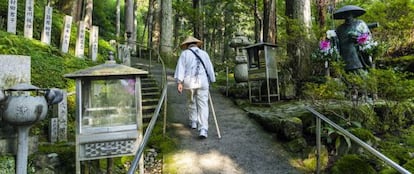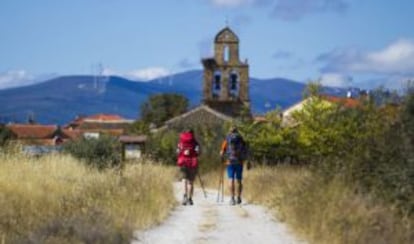Japan looks to Camino de Santiago as model for its own pilgrimage route
Japanese and Galician officials to work together to promote temple circuits among tourists

Now that the best malt whisky in the world bears a Japanese, rather than a Scottish, label, the Land of the Rising Sun has decided it wants to create its own version of the Camino de Santiago, the popular Spanish pilgrimage route that terminates in Santiago de Compostela, Galicia.
The head of the Galicia regional government, Alberto Núñez Feijoó, and the governor of Japan’s Kagawa province, on the central island of Shikoku, recently signed an agreement to work together to promote the Shikoku Pilgrimage, known as the Way of the 88 Temples.
The Japanese government is hoping to take advantage of the Camino de Santiago to develop the niche religious tourism sector
The ultimate goal is to have it “recognized as a World Heritage Site based on learning from the long and abundant experience that the Camino de Santiago possesses.”
Japan already has one Unesco World Heritage Site pilgrimage route, the Kumano Kodō, which passes along Shinto and Buddhist temples in southeastern Japan.
Also known as the Shikoku-Henro, the Way of the 88 Temples will connect with the Kumano Kodō in Koya-san, the ancient monastery city. The way follows the route traveled by ninth-century monk Kukai, who founded the Shingon school of Buddhism. Around half a million pilgrims walk the circular 1,200-kilometer route each year. Tradition requires them to do so clockwise.

The Japanese government is hoping to take advantage of the Camino de Santiago to develop a niche religious tourism sector, creating its own pilgrimage circuit by uniting the two routes. The hope is that it will help boost the country’s ailing economy, as well as opening up what is still a largely insular society that has one of the lowest immigration levels in the developed world.
As with the Camino de Santiago, Japanese tourism authorities will be hoping to attract visitors also interested in trying local cuisine. The local Udon noodle and seaweed soup that comes in dozens of varieties is among the best-known dishes in the region. The area also has its own native species of chicken, as well as its particular way of preparing tuna and sea bass sashimi.
Approximately 460,000 Japanese tourists visit Spain each year, and many of them travel along sections of the many routes that lead to the tomb of Saint James in Santiago de Compostela, attracted by the Camino’s blend of religion, culture and gastronomy.
“We hope that the Kumano Kodō and the Shikoku-Henro will be as popular among Spaniards,” says a spokesman at the Japanese embassy.
Around 64,000 Spaniards traveled to Japan last year, although numbers for the first quarter of 2015 rose by 24.6 percent, suggesting that it will be a record year.
Tu suscripción se está usando en otro dispositivo
¿Quieres añadir otro usuario a tu suscripción?
Si continúas leyendo en este dispositivo, no se podrá leer en el otro.
FlechaTu suscripción se está usando en otro dispositivo y solo puedes acceder a EL PAÍS desde un dispositivo a la vez.
Si quieres compartir tu cuenta, cambia tu suscripción a la modalidad Premium, así podrás añadir otro usuario. Cada uno accederá con su propia cuenta de email, lo que os permitirá personalizar vuestra experiencia en EL PAÍS.
¿Tienes una suscripción de empresa? Accede aquí para contratar más cuentas.
En el caso de no saber quién está usando tu cuenta, te recomendamos cambiar tu contraseña aquí.
Si decides continuar compartiendo tu cuenta, este mensaje se mostrará en tu dispositivo y en el de la otra persona que está usando tu cuenta de forma indefinida, afectando a tu experiencia de lectura. Puedes consultar aquí los términos y condiciones de la suscripción digital.
Últimas noticias
Maduro pleads not guilty before the federal court in New York: ‘I am still the president of Venezuela’
A new test can detect Alzheimer’s from a finger prick
UN team enters Sudanese city of El Fasher after paramilitary massacre: ‘It’s like a ghost town’
A recipe for resistance: Indigenous peoples politicize their struggles from the kitchen
Most viewed
- Gilles Lipovetsky: ‘If you want to live better and fall in love, take Prozac, don’t look to philosophy’
- Alain Aspect, Nobel laureate in physics: ‘Einstein was so smart that he would have had to recognize quantum entanglement’
- Alvin Hellerstein, a 92-year-old judge appointed by Bill Clinton, to preside over Maduro’s trial in New York
- Why oil has been at the center of Venezuela-US conflicts for decades
- Cuba confirms death of 32 of its citizens in the US attack against Venezuela









































